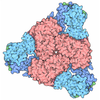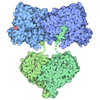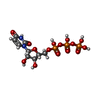[English] 日本語
 Yorodumi
Yorodumi- PDB-6pk4: cryoEM structure of the substrate-bound human CTP synthase 2 filament -
+ Open data
Open data
- Basic information
Basic information
| Entry | Database: PDB / ID: 6pk4 | ||||||
|---|---|---|---|---|---|---|---|
| Title | cryoEM structure of the substrate-bound human CTP synthase 2 filament | ||||||
 Components Components | CTP synthase 2 | ||||||
 Keywords Keywords | PROTEIN FIBRIL / Enzyme / filament | ||||||
| Function / homology |  Function and homology information Function and homology informationcytoophidium / CTP synthase (glutamine hydrolysing) / CTP synthase activity / pyrimidine nucleotide metabolic process / 'de novo' CTP biosynthetic process / pyrimidine nucleobase biosynthetic process / Interconversion of nucleotide di- and triphosphates / CTP biosynthetic process / mitochondrion / ATP binding ...cytoophidium / CTP synthase (glutamine hydrolysing) / CTP synthase activity / pyrimidine nucleotide metabolic process / 'de novo' CTP biosynthetic process / pyrimidine nucleobase biosynthetic process / Interconversion of nucleotide di- and triphosphates / CTP biosynthetic process / mitochondrion / ATP binding / identical protein binding / cytosol / cytoplasm Similarity search - Function | ||||||
| Biological species |  Homo sapiens (human) Homo sapiens (human) | ||||||
| Method | ELECTRON MICROSCOPY / single particle reconstruction / cryo EM / Resolution: 3.5 Å | ||||||
 Authors Authors | Lynch, E.M. / Kollman, J.M. | ||||||
 Citation Citation |  Journal: Nat Struct Mol Biol / Year: 2020 Journal: Nat Struct Mol Biol / Year: 2020Title: Coupled structural transitions enable highly cooperative regulation of human CTPS2 filaments. Authors: Eric M Lynch / Justin M Kollman /  Abstract: Many enzymes assemble into defined oligomers, providing a mechanism for cooperatively regulating activity. Recent studies have described a mode of regulation in which enzyme activity is modulated by ...Many enzymes assemble into defined oligomers, providing a mechanism for cooperatively regulating activity. Recent studies have described a mode of regulation in which enzyme activity is modulated by polymerization into large-scale filaments. Here we describe an ultrasensitive form of polymerization-based regulation employed by human CTP synthase 2 (CTPS2). Cryo-EM structures reveal that CTPS2 filaments dynamically switch between active and inactive forms in response to changes in substrate and product levels. Linking the conformational state of many CTPS2 subunits in a filament results in highly cooperative regulation, greatly exceeding the limits of cooperativity for the CTPS2 tetramer alone. The structures reveal a link between conformation and control of ammonia channeling between the enzyme's active sites, and explain differences in regulation of human CTPS isoforms. This filament-based mechanism of enhanced cooperativity demonstrates how the widespread phenomenon of enzyme polymerization can be adapted to achieve different regulatory outcomes. | ||||||
| History |
|
- Structure visualization
Structure visualization
| Movie |
 Movie viewer Movie viewer |
|---|---|
| Structure viewer | Molecule:  Molmil Molmil Jmol/JSmol Jmol/JSmol |
- Downloads & links
Downloads & links
- Download
Download
| PDBx/mmCIF format |  6pk4.cif.gz 6pk4.cif.gz | 389.8 KB | Display |  PDBx/mmCIF format PDBx/mmCIF format |
|---|---|---|---|---|
| PDB format |  pdb6pk4.ent.gz pdb6pk4.ent.gz | 324.2 KB | Display |  PDB format PDB format |
| PDBx/mmJSON format |  6pk4.json.gz 6pk4.json.gz | Tree view |  PDBx/mmJSON format PDBx/mmJSON format | |
| Others |  Other downloads Other downloads |
-Validation report
| Summary document |  6pk4_validation.pdf.gz 6pk4_validation.pdf.gz | 1.5 MB | Display |  wwPDB validaton report wwPDB validaton report |
|---|---|---|---|---|
| Full document |  6pk4_full_validation.pdf.gz 6pk4_full_validation.pdf.gz | 1.5 MB | Display | |
| Data in XML |  6pk4_validation.xml.gz 6pk4_validation.xml.gz | 69.1 KB | Display | |
| Data in CIF |  6pk4_validation.cif.gz 6pk4_validation.cif.gz | 99.2 KB | Display | |
| Arichive directory |  https://data.pdbj.org/pub/pdb/validation_reports/pk/6pk4 https://data.pdbj.org/pub/pdb/validation_reports/pk/6pk4 ftp://data.pdbj.org/pub/pdb/validation_reports/pk/6pk4 ftp://data.pdbj.org/pub/pdb/validation_reports/pk/6pk4 | HTTPS FTP |
-Related structure data
| Related structure data |  20354MC  6pk7C M: map data used to model this data C: citing same article ( |
|---|---|
| Similar structure data |
- Links
Links
- Assembly
Assembly
| Deposited unit | 
|
|---|---|
| 1 |
|
- Components
Components
| #1: Protein | Mass: 65759.430 Da / Num. of mol.: 4 Source method: isolated from a genetically manipulated source Source: (gene. exp.)  Homo sapiens (human) / Gene: CTPS2 / Production host: Homo sapiens (human) / Gene: CTPS2 / Production host:  References: UniProt: Q9NRF8, CTP synthase (glutamine hydrolysing) #2: Chemical | ChemComp-UTP / #3: Chemical | ChemComp-ATP / Has ligand of interest | N | |
|---|
-Experimental details
-Experiment
| Experiment | Method: ELECTRON MICROSCOPY |
|---|---|
| EM experiment | Aggregation state: FILAMENT / 3D reconstruction method: single particle reconstruction |
- Sample preparation
Sample preparation
| Component | Name: substrate-bound CTP synthase 2 filament / Type: COMPLEX / Entity ID: #1 / Source: RECOMBINANT |
|---|---|
| Source (natural) | Organism:  Homo sapiens (human) Homo sapiens (human) |
| Source (recombinant) | Organism:  |
| Buffer solution | pH: 7.9 |
| Specimen | Embedding applied: NO / Shadowing applied: NO / Staining applied: NO / Vitrification applied: YES |
| Vitrification | Cryogen name: ETHANE |
- Electron microscopy imaging
Electron microscopy imaging
| Experimental equipment |  Model: Titan Krios / Image courtesy: FEI Company |
|---|---|
| Microscopy | Model: FEI TITAN KRIOS |
| Electron gun | Electron source:  FIELD EMISSION GUN / Accelerating voltage: 300 kV / Illumination mode: FLOOD BEAM FIELD EMISSION GUN / Accelerating voltage: 300 kV / Illumination mode: FLOOD BEAM |
| Electron lens | Mode: BRIGHT FIELD |
| Image recording | Electron dose: 90 e/Å2 / Detector mode: SUPER-RESOLUTION / Film or detector model: GATAN K2 SUMMIT (4k x 4k) |
- Processing
Processing
| EM software |
| |||||||||||||||||||||
|---|---|---|---|---|---|---|---|---|---|---|---|---|---|---|---|---|---|---|---|---|---|---|
| CTF correction | Type: PHASE FLIPPING AND AMPLITUDE CORRECTION | |||||||||||||||||||||
| Symmetry | Point symmetry: D2 (2x2 fold dihedral) | |||||||||||||||||||||
| 3D reconstruction | Resolution: 3.5 Å / Resolution method: FSC 0.143 CUT-OFF / Num. of particles: 53964 / Symmetry type: POINT |
 Movie
Movie Controller
Controller



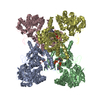
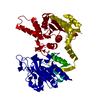
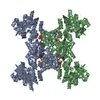
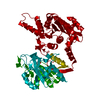
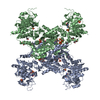
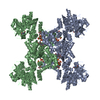
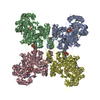
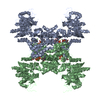
 PDBj
PDBj